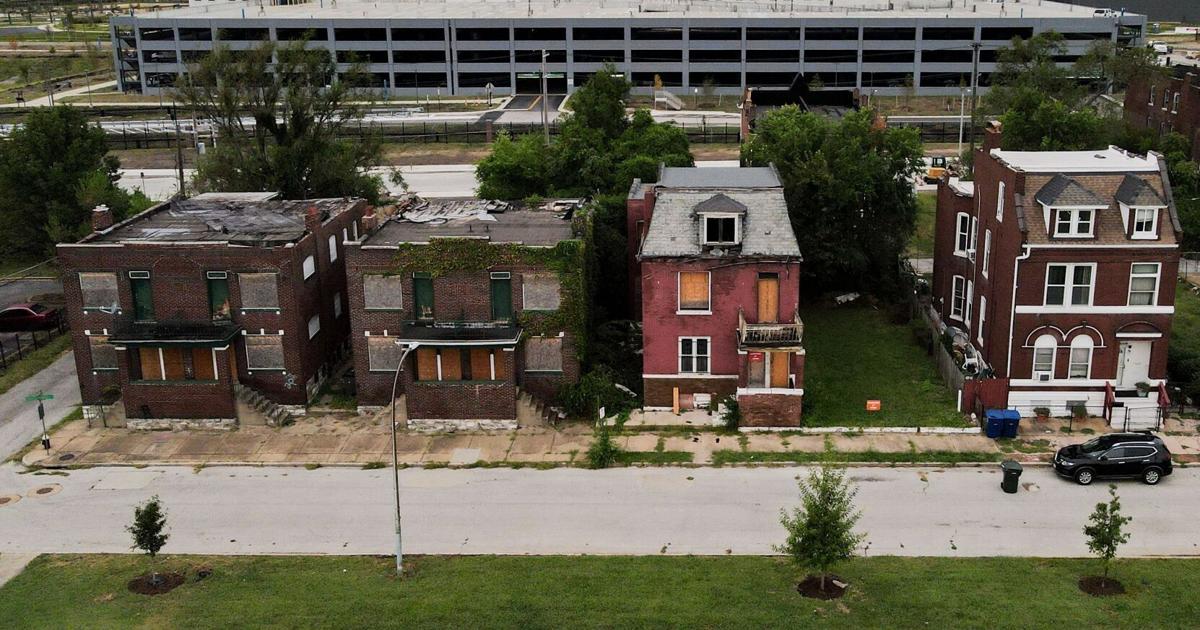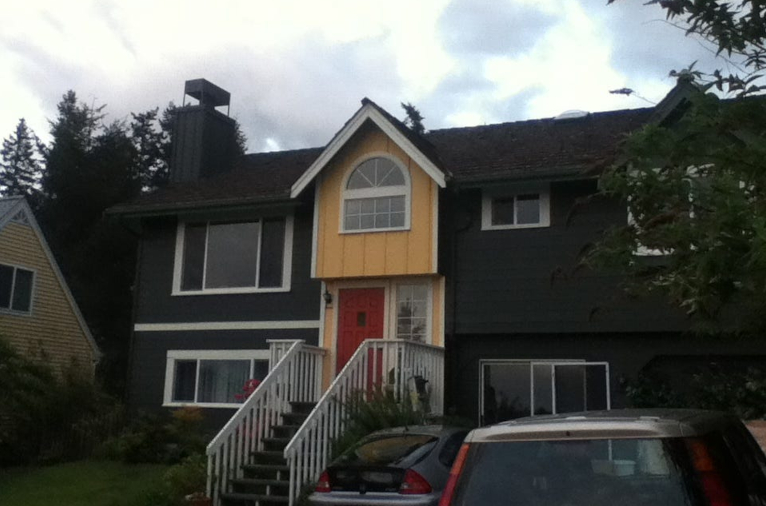
ST. LOUIS — New landscaping and a pristine streetscape wraps around the National Geospatial-Intelligence Agency’s soon-to-open north side campus at Jefferson and Cass avenues. A tall concrete median that runs north on Jefferson is now erected to slow drag racers, and the grass on the northeastern corner is manicured and cut short.
One block east in the St. Louis Place neighborhood, commuters dodge potholes and cracked sidewalks. A handful of vacant buildings with overgrown weeds loom in the background. “Do not let geospatial get this!” is spray-painted on a boarded-up building along North 22nd Street on the campus’ east side.
The progress officials have long said would come with the new NGA campus has not arrived at everyone’s doorstep in north St. Louis.
“There’s a lot of money over there,” resident Theo Ballinger said, pointing toward the sprawling NGA grounds, “but not money here.”
Since 2019, city and business leaders have pinned their hopes for St. Louis’ future on the high-tech campus that is uprooting 3,000 employees from their outdated barracks near Anheuser-Busch Brewery 5 miles south. It’s the largest federal investment in St. Louis history and local officials want to squeeze every opportunity from it. A grand opening is set for Friday. Employees will begin to move in this fall.
Investment in the six, predominately Black neighborhoods surrounding NGA’s 92 acres, however, has been slow.
Project Connect, a city-endorsed effort to have residents of those neighborhoods — St. Louis Place, Carr Square, Jeff-Vander-Lou, Old North, Hyde Park and Columbus Square — lead redevelopment planning has been plagued by delays and a handful of starts and stops over the past nine years. Some of the residents who formed the neighborhood committees dropped out as a result. A draft of the plan that has taken years and several consultants to produce is expected to be released next month.
More than a few residents question whether NGA will be the economic silver bullet leaders hope it will be, especially because no money has been earmarked for the changes the neighborhoods want. Lately, they have begun to wonder whether turnover at the city’s development agency and the May tornado have made their neighborhoods less of a focus.
“A handful of people put in real time for nada,” said resident Brian Krueger, who has been involved in Project Connect since the beginning.
City development officials acknowledge missteps around Project Connect, but insist it remains priority.
Otis Williams, interim leader of St. Louis Development Corp., the city’s economic development agency, said the plan being released next month will have a long-term impact on the future of the area.
He disputed the idea there has been no change, particularly when it comes to critical infrastructure. He specifically noted the addition of a new interchange at Jefferson and Interstate 64 that he said will aid Project Connect and future development. The city, he said, is working to gain control of more parcels to help foster other business or housing projects.
“I do believe that we are poised now to go forward and make some of the things that we had envisioned earlier to come to fruition,” said Williams. “We have a plan of action.”
The new NGA western campus stands apart on the North Side, not just for its size and scope, but for its sleek architecture, featuring a modern series of boxy buildings, manicured landscaping and smooth sidewalks.
Brick buildings fan out from its borders, some still bearing the pride of being located on what once was known as St. Louis’ Millionaires’ Row just one street north. Others, blocks away and throughout the north side, more resemble dollhouses with missing facades and exterior walls. Quality can vary on a single block.
Some work is underway. A few adjacent apartment buildings one block east at 22nd and Madison Street are being renovated, and new low-income housing four blocks south is under construction. Another developer is hoping to add more affordable housing.
To Roman McKinney, a junior at Vashon High School, his community has not experienced much change. He has watched the NGA campus be built on his walk to school, but he is not sure what goes on there or what impact it would have for his neighborhood.
On the other side of the St. Louis Place Park basketball courts where McKinney likes to shoot hoops, Theo Ballinger was walking with his granddaughter, River.
He likes the new sidewalks and repaved streets that outline the NGA campus, but said those should have happened without the agency. And he thinks the bigger impact would have been to employ people who live in the immediate area.
Too many in his community, Ballinger said, are like “crabs in a bucket. They’re climbing over each other to get to the top just to survive.”
He has his doubts about the future. Signs across from NGA on Jefferson and Cass that teased a new innovation district have long since faded. The Homer G. Phillips Memorial Hospital, one block south on Jefferson, was not open for a year before it closed. It was a small hospital, more like a clinic, but it was something, Ballinger said.
The hospital was built by developer Paul McKee, a key project in his plan to transform the city’s struggling North Side. The O’Fallon, Missouri-based developer bought hundreds of properties more than two decades ago. NGA now occupies a portion of it.
He has been criticized, however, for letting most of the properties deteriorate into hazards and attract crime. He has been in a years-long fight with the city over it.
City officials positioned Project Connect as a counter to that.
Beginning in 2016, Project Connect sent a call out to residents asking them to get involved.
The process since then has been slow and intermittent. The consultant firm hired to help guide residents was fired, and for about a year nothing else happened, said Krueger, the St. Louis Place resident who long has been involved with Project Connect.
There was no communication from the city over the delay, and Krueger said he thinks SLDC’s troubled grant program, the mayoral election, a change of SLDC leadership and the May tornado may have been distractions.
“The delay was really a burden,” Krueger said. “I’m not sure they completely explained it.”
Curtis Griggs, the neighborhood transformation manager for St. Louis Development Corp. and one of the city’s new leaders for Project Connect, conceded that communication with residents could have been better. And he recognizes there has been “bleed out” of resident involvement.
The fired consultants, he said, were not producing “deliverables,” such as a plan that put residents’ desires at the center. It then took time to find a new consultant. Meanwhile, several city-appointed leaders at Project Connect left.
Griggs is hoping transparency and communication will build back trust.
“I’m a lifelong resident of Jeff-Vander-Lou, so a lot of issues our (residents) had, I also shared those,” Griggs said.
He said he has spent much of his time on the project explaining the policy side, including funding, misconceptions around tax dollars and incentives and assuaging neighborhood fears the NGA could send housing prices soaring and push residents out.
“We had to set the tone,” Griggs said.
He expects a draft plan to be released by mid-October. The public will have a chance to weigh in with changes or recommendations before going to the Planning Commission for approval. After that, strategic planning of specific projects will begin.
Some residents acknowledge that change takes time.
Longtime Old North residents Marion Evans and her husband, Jeffrey, spent several years putting together their new business. Finally, last month, The Daily Drip opened on North 14th Street in the former La Mancha Coffeehouse in Old North.
She is hoping the new NGA complex will create more businesses to complement the retail shops along Old North’s business corridor. There are enough residents in her neighborhood to support it, she said.
The block where her and her husband live is “almost at capacity,” Evans said.
“It’s good to see.”
Get Government & Politics updates in your inbox!
Stay up-to-date on the latest in local and national government and political topics with our newsletter.
* I understand and agree that registration on or use of this site constitutes agreement to its user agreement and privacy policy.
Steph Kukuljan | Post-Dispatch
Real estate and development
Get email notifications on {{subject}} daily!
Your notification has been saved.
There was a problem saving your notification.
{{description}}
Email notifications are only sent once a day, and only if there are new matching items.
Followed notifications
Please log in to use this feature
Log In
Don’t have an account? Sign Up Today



